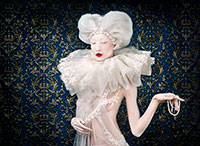
Melbourne-based Samantha Everton is internationally recognised for her sumptuous visual narratives of cross-cultural, socio-historical and psychological relevance. Everton’s new photographic series, Indochine, explores the repercussions concomitant in the meeting of Eastern and Western traditions – a confluence that began during the 16th century when European trading companies made forays into exotic realms. Contrary to Everton’s previous series that were set in surrealistic three-dimensional spaces, Indochine depicts an Oriental woman variously posed against flat, intensely ornate backdrops. Her costumes are integral emblematic factors imparting Everton’s observations of how fashion throughout history has been a signifier of female identity. The portraits manifest a woman caught between the cultural values and expectations of her particular time, and a deep interiority that is struggling towards individuation. Implanted within the amplified colouration and ornamental intricacies are symbolic elements that offer clues to the underlying stories. Entailing eighteen months of international collaboration and research, Everton went to quite extraordinary lengths in finding exactly the right accoutrements for the Indochine images. Commissioned, hand-painted Chinoiserie wallpapers were shipped from China. An exquisite neckpiece was designed and made by Cirque du Soleil’s Larry Edwards. The actual shoot using a medium format camera took place in a Ho Chi Minh City studio. Extending over a gruelling two weeks period, the session incidentally involved a bicycling venture across Vietnamese swamplands to source the living bird and snake props. Her model, Trang Pham, flew in from a London fashion assignment the day before the shoot’s commencement. Anomalies abound in Everton’s Alabaster image. Strict codes of dress denoting social stature and moral values governed the Elizabethan era. During the 1580’s neck ruffs were the vogue, the intention being to draw the onlookers’ gaze towards the face. Despite the enormous ruff, flamboyant hairstyle and wallpaper emblazoned with English crests, the woman here is the very antithesis of Elizabethan mores. A vision in diaphanous white, she appears quite indifferent to her revealed nakedness. Adorning the damsel’s hair are pearls that were in those days symbolic of purity and loyalty. The strand of pearls dangling from an outstretched hand may indicate a proffered adherence to that ideal or conversely, a wilful rejection. Slashes of rouge directing one’s attention to the scarlet pouting lips perhaps suggest the latter. An air of wistful nobility pervades the Xiao Majia portrait. Haloed against an inky entanglement of white orchid-strewn foliage, the woman’s attitude is meditative, her hands gently clasped. She is adorned in a crown of black roses. It is a work imbued in symbolism. Coloured orchids in Chinese lore denote springtime and often festoon wedding and religious ceremonies. White orchids, however, have a more sombre significance, as do black roses. Both portend farewells and endings, but as such, they also herald rebirth or the beginnings of something new. The dragon embroidered upon the model’s breastplate is an archetypal symbol of transformation. Xiao Majia translates as ‘little vest’. It refers to the heavy, long collar plates adopted by Chinese high-ranking females when the centuries-old practice of breast binding ended in the 1920’s. During that era, Shanghai was a ferment of Western influences.Fast-forward to the 21st century where cyber technology has homogenised cultural perspectives and largely invalidated age-old traditions for the young. The Femme Fatale image playfully highlights an extreme of ‘East meets the West’ exchange. Manga comic-like in her unnaturally pale skin, white hair and wide blue eyes, this young Asian woman’s demeanour is impassive. The work parodies pop culture icons and the rampant excesses of consumerism in its references to both Britney Spears and Rihanna. Britney released an album titled Femme Fatale and also famously performed with a live Albino Burmese Python draped around her shoulders. Rihanna made headlines with the sale of her coronet-like, gold Dolce & Gabbana bejewelled headphones. In this image the figure’s headphones are not encrusted with precious stones but instead a purple toy car, My Little Pony effigies and a fluffy flamingo. Truong Son is the final and least embellished image in the portrait series: the setting is nondescript. The character’s head tilts to the side, a lock of pink hair brushes her face. Blue eyes and simple collared blouse evidence a Western affiliation. With a direct gaze and nonchalant posture, she negates any censure in a languid exhalation of cigarette smoke. This woman conveys the impression of being ultimately at ease with herself.
Receive e-mail updates on our exhibitions, events and more
Subscribe Now